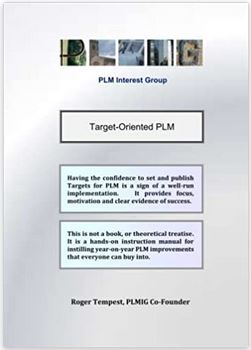|
PLM Interest Group |
|||||||||||||||||||||||
|
|
|
|
|||||||||||||||||||||
|
|
|
|||||||||||||||||||||
|
|
|
|
|||||||||||||||||||||
|
Target-Oriented PLM
Planning with Pizazz
PLM planning is often done out of sight, behind the scenes, below the radar. There is a general feeling that so many things can go wrong, it is best not to be too bold. But having the confidence to set and publish Targets for PLM is a sign of a well-run implementation. It provides focus, motivation and clear evidence of success. The Target-Oriented PLM methodology is a hands-on instruction set for instilling year-on-year PLM improvements that everyone can buy into. What Is It, and What Does It Do?
People work better when they can see a picture of what they are working towards. PLM Teams are more effective if they are bold enough to aim for specific and well-publicised results. The greatest progress is achieved by aiming high, setting challenging targets, and getting everyone on board to achieve them.
The exercise of translating into Targets and back into plans is a chance for an informal but effective review of where PLM is going, and what it can achieve. The bar can be raised, so future development is faster and more comprehensive, and covers more ground. The Handbook shows how to establish the most effective target set, and then re-iterate every year with a drumbeat of clear and proven achievement. It raises the profile of PLM planning and makes a feature of the benefits that PLM will achieve, in order to revitalise and optimise the way that PLM evolves through the enterprise. How Do I Use It?
The methodology equips a conventional PLM project planning system with a natural array of embedded targets that everyone can relate to, making the programme more understandable and easier to support. There is a Standardised, 18-month-long Project Template that you can superimpose on your existing planning, to navigate your way through the target-setting process. The first 6 months comprise a structured programme of Orientation, Diagnosis and Calibration to determine what the targets should be; and the next 12 months cover the elapsed time to achieve them. Every company's detailed project planning systems are different, but the Navigation Template is a Standard - which means that however 'different' or customised the planning system, the same analysis can be performed. The Project Template is a standard length, but there is no intention to impose arbitrary timescales on the working PLM plans. The aim is to identify 'natural' targets and times that fit in with the essence of the current programme. The first pass of the Methodology declares Targets after 6 months that are a year away from the Declaration. Thereafter there is a period of Review and Recalibration, to assess progress and lessons learned; and then target-setting can become an annual activity. How Do I Get One?
The Target-Oriented PLM Handbook is provided with Q&A support to PLMIG Members, so you will receive a copy if you join with any class of Membership. Alternatively, you may buy hard copies from Amazon. For more information about Target-Oriented PLM, or the Handbook itself, contact targetedplm@plmig.com. © Copyright 2025 PLM Interest Group |
||||||||||||||||||||||
| <<< Return Home | |||||||||||||||||||||||
|
|
|
|
|||||||||||||||||||||
|
|
|||||||||||||||||||||||





